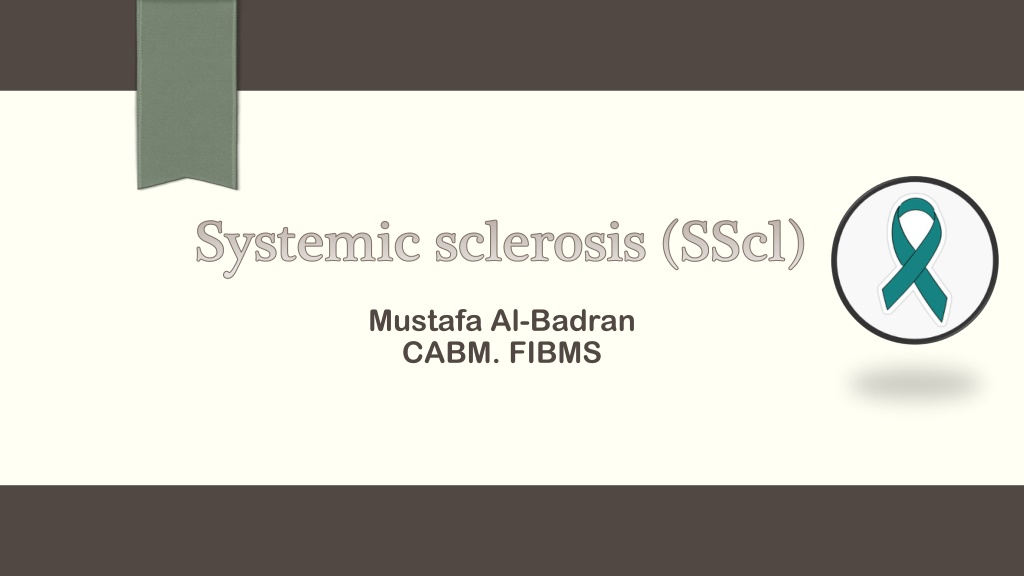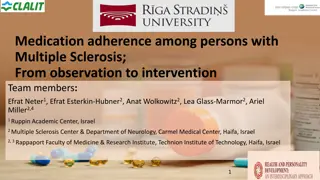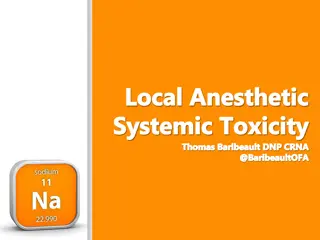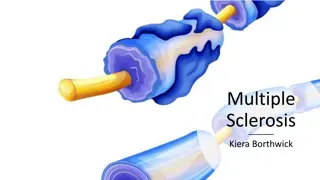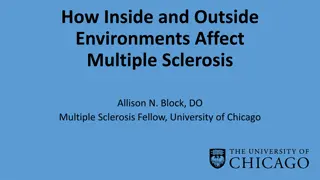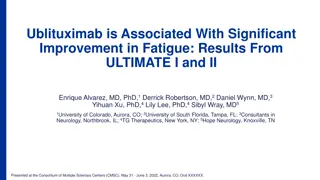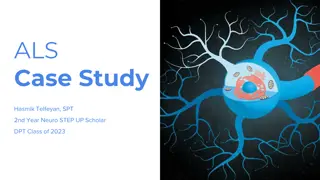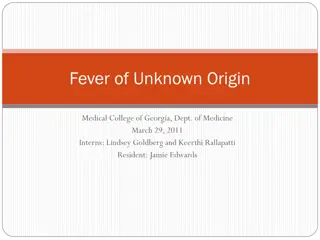Understanding Systemic Sclerosis: Causes, Symptoms, and Management
Systemic sclerosis (SScl) is an autoimmune disorder affecting connective tissue, leading to fibrosis in the skin, internal organs, and vasculature. It is characterized by Raynaud's phenomenon, digital ischemia, sclerodactyly, and cardiac, lung, gut, and renal involvement. Peak onset is in the fourth and fifth decades with a female predilection. Pathophysiology involves genetic and immunological factors contributing to fibroblast activation and skin thickening. Clinical features include skin changes and organ involvement, with differentiation into diffuse and limited cutaneous types. Early recognition and management are crucial for improving outcomes.
Download Presentation

Please find below an Image/Link to download the presentation.
The content on the website is provided AS IS for your information and personal use only. It may not be sold, licensed, or shared on other websites without obtaining consent from the author. Download presentation by click this link. If you encounter any issues during the download, it is possible that the publisher has removed the file from their server.
E N D
Presentation Transcript
Systemic sclerosis ( Systemic sclerosis (SScl) SScl) Mustafa Al-Badran CABM. FIBMS
Autoimmune disorder of connective tissue, which results in fibrosis affecting the Skin Internal Organs Vasculature It is characterised typically by Raynaud s phenomenon Digital ischaemia Sclerodactyly Cardiac, Lung, Gut and Renal disease
Epidemiology Peak age of onset is in the fourth and fifth decades Prevalence is 10 20 per 100 000, with a 4 : 1 female-to-male. It is subdivided into Diffuse cutaneous systemic sclerosis (dcSScl: 30% of cases) Limited cutaneous systemic sclerosis (lcSScl: 70% of cases)
Pathophysiology The cause of SScl is not completely understood Evidence for a genetic component Evidence of immunological dysfunction T lymphocytes(Th17 subtype) infiltrate the skin result in abnormal fibroblast activation, leading to increased production of extracellular matrix in the dermis (type I collagen) & results in Symmetrical thickening, tightening and induration of the skin (scleroderma) Arterial and arteriolar narrowing occurs due to intimal proliferation and vessel wall inflammation Endothelial injury causes release of vasoconstrictors and platelet activation, resulting in further ischaemia
1. Skin Initially, there is non-pitting oedema of fingers and flexor tendon sheaths Subsequently, the skin becomes shiny and taut, and distal skin creases disappear and with capillary loss
The face and neck are often involved, with thinning of the lips and radial furrowing Skin involvement restricted to sites distal to the elbow or knee is thus classified as lcSScl Involvement proximal to the knee and elbow and on the trunk is classified as diffuse disease dcSScl
2. Raynauds phenomenon Universal and precede other features by many years Cause critical tissue ischaemia, leading to localized distal skin infarction and necrosis
3.Musculoskeletal Arthralgia and flexor tenosynovitis Restricted hand function is due to skin rather than joint disease and erosive arthropathy is uncommon Muscle weakness and wasting (Myositis )
4. Gastrointestinal involvement Oesophagus involvement lead to reflux with erosive esophagitis (Smooth muscle atrophy and fibrosis in the lower two-thirds) Stomach involvement lead to early satiety and outlet obstruction Recurrent occult upper gastrointestinal bleeding may indicate a watermelon stomach (antral vascular ectasia; up to 20% of patients) Small intestine involvement may lead to Malabsorption due to bacterial overgrowth Intermittent bloating, pain or constipation Pseudo-obstruction (due to autonomic neuropathy )
5. Pulmonary involvement Pulmonary hypertension complicates long-standing disease and is six times more prevalent in lcSScl than in dcSScl Interstitial lung disease is common in patients with dcSScl who have topoisomerase 1 antibodies (Scl70)
6. Renal involvement Hypertensive renal crisis (main causes of death ) characterised by rapidly developing accelerated phase hypertension renal failure Hypertensive renal crisis is much more likely to occur in 1. dcSScl than in lcSScl 2. patients with topoisomerase 1 and RNP antibodies Treatment by ACEi
Investigations Investigations ANA positive in about 70% Topoisomerase 1 (Scl70) positive in about 30% of patients with dcSScl Anticentromere antibodies positive in about 60% of patients with lcSScl High-resolution lung CT is recommended if interstitial lung disease suspected. If pulmonary hypertension is suspected by transthoracic echocardiography and lung function tests, right heart catheter measurements should be arranged
Management Management The management to slow the effects of the disease on target organs No treatments are available that halt or reverse the fibrotic changes
Raynauds Phenomenon and Digital Ulcers Avoidance of cold exposure Use of thermal insulating gloves/socks Maintenance of a high core temperature Calcium channel blockers Losartan Fluoxetine Sildenafil
Courses of intravenous prostacyclin are used for severe disease and critical ischemia (e.g. 6 8 hours daily for 5 days). The endothelin-1 antagonist (Bosentan) is licensed for treating ischaemic digital ulcers
Gastrointestinal Complications Oesophageal reflux proton pump inhibitors Bacterial overgrowth Rotating courses of antibiotics (e.g. Rifaximin, a tetracycline and metronidazole), Dysmotility/ Pseudo-obstruction metoclopramide or domperidone
Hypertensive Renal Crisis & Hypertension Aggressive treatment with ACE inhibitors is needed, even if renal impairment is present.
Joint Involvement Analgesics and/or NSAIDs Low-dose Methotrexate
Progressive pulmonary hypertension Early treatment with bosentan is required In severe or progressive disease, heart lung transplant may be considered.
Interstitial Lung Disease Glucocorticoids and (pulse intravenous) cyclophosphamide
The prognosis in dcSScl is poor (5-year survival about 70%) Prognosis Features that associate with a poor prognosis include Older age Diffuse Skin disease Proteinuria High ESR Low (TLCO) Pulmonary hypertension
